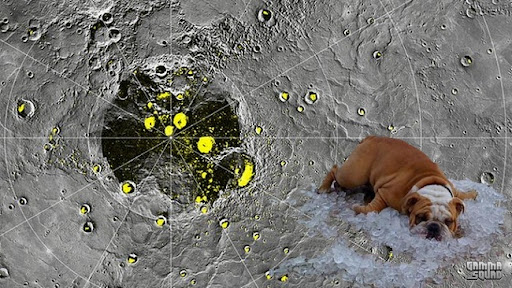
NASA’s Messenger probe has been orbiting Mercury since March of last year (the first probe to have done so). The surface temperature of Mercury varies between -180 C and 425 C (-292 F and 797 F), with some areas at the poles being extremely cold year-round despite the planet’s close proximity to the Sun. Earlier this year we reported the Johns Hopkins University Applied Physics Laboratory found evidence that ice may be present in the sunlight-blocking craters on Mercury’s north pole. The yellow in the photos above and below are the locations at which radar testing indicated a possible presence of ice. The picture below is a recent thermal map of Mercury’s pole; the red parts are permanently shadowed areas, which line up closely with the yellow spots of probably-ice.

In addition to thermal mapping and radar testing, a neutron spectrometer aboard Messenger also found strong evidence of water beneath the surface of Mercury in those yellow areas pictured.
The ice appears to be buried a few dozen centimeters beneath the surface, and may be from half a meter to 20 meters (20 inches to more than 60 feet) thick. That adds up to an amazing 100 billion to one trillion tons of ice! [...] The irony of finding water ice on such a hot planet is obvious, but also an indication that water is everywhere in our solar system, from close in to the Sun to the farthest reaches we can see, billions of kilometers out past Neptune. [Bad Astronomy]
That’s heavy.
Also, here’s a very technical, totally-real video showing one of these craters up close.
[Thanks to James for the video.]
The post Mercury Almost Definitely Has Ice At Its North Pole appeared first on UPROXX.
No comments:
Post a Comment